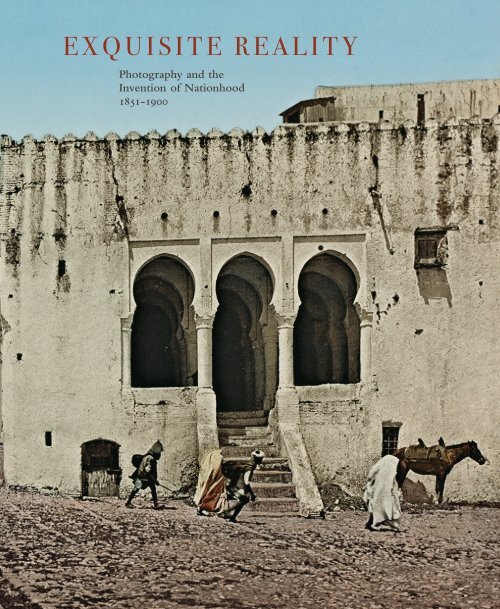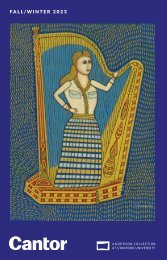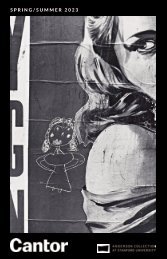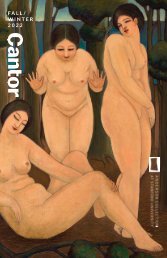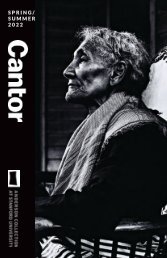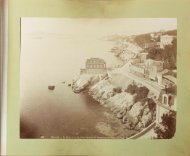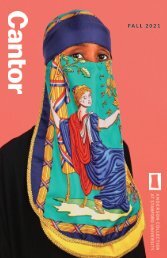Exquisite Reality: Photography and the Invention of Nationhood, 1851–1900
Review the publication that accompanies "Exquisite Reality: Photography and the Invention of Nationhood, 1851-1900."
Review the publication that accompanies "Exquisite Reality: Photography and the Invention of Nationhood, 1851-1900."
You also want an ePaper? Increase the reach of your titles
YUMPU automatically turns print PDFs into web optimized ePapers that Google loves.
EXQUISITE REALITY<br />
<strong>Photography</strong> <strong>and</strong> <strong>the</strong><br />
<strong>Invention</strong> <strong>of</strong> <strong>Nationhood</strong><br />
1851-1900
To view this online exhibition please visit<br />
http://cantor.2.vu/exquisite
EXQUISITE REALITY<br />
<strong>Photography</strong> <strong>and</strong> <strong>the</strong><br />
<strong>Invention</strong> <strong>of</strong> <strong>Nationhood</strong><br />
1851-1900<br />
Danny Smith
EXQUISITE REALITY<br />
<strong>Photography</strong> <strong>and</strong> <strong>the</strong><br />
<strong>Invention</strong> <strong>of</strong> <strong>Nationhood</strong><br />
1851-1900<br />
fig. 1<br />
Félix Bonfils (French,<br />
1831–1885), Caliph’s Tomb,<br />
19th century. Albumen<br />
print. Gift <strong>of</strong> Joseph Folberg,<br />
1994.86.10<br />
THE CITY OF THE DEAD<br />
In 1867, a young French bookbinder named Félix Bonfils opened a photography<br />
studio in Beirut. From <strong>the</strong> Lebanese capital he traveled across <strong>the</strong><br />
Middle East, making portraits <strong>and</strong> capturing architectural images <strong>and</strong> sweeping<br />
l<strong>and</strong>scapes. 1 On one visit to Cairo, Bonfils took a picture <strong>of</strong> <strong>the</strong> mausolea <strong>of</strong><br />
<strong>the</strong> medieval Abbasid Caliphate in Cairo’s al-Qarafa ,(ةفارقلا) <strong>the</strong> sprawling<br />
cemetery known in English as <strong>the</strong> City <strong>of</strong> <strong>the</strong> Dead (fig. 1). In <strong>the</strong> photograph,<br />
in front <strong>of</strong> <strong>the</strong> domed mausolea <strong>and</strong> minarets <strong>of</strong> <strong>the</strong> mosques, five camels<br />
st<strong>and</strong> in perfect pr<strong>of</strong>ile. A small child in dark robes holds <strong>the</strong> first camel on a<br />
lead. O<strong>the</strong>rs, similarly clad in Bedouin robes <strong>and</strong> turbans, congregate around<br />
<strong>the</strong> o<strong>the</strong>r camels. Bonfils’s photograph is taken from a distance such that fully<br />
<strong>the</strong> bottom third shows Cairo’s dusty, rocky soil. The solemnity <strong>of</strong> <strong>the</strong> figures,<br />
<strong>the</strong> silence <strong>of</strong> <strong>the</strong> tombs, <strong>and</strong> <strong>the</strong> almost geometric rigidity <strong>of</strong> <strong>the</strong> camels all<br />
project <strong>the</strong> formal air <strong>of</strong> a funeral. Bonfils’s own distance from <strong>the</strong> scene puts<br />
<strong>the</strong> viewer at a respectful remove. At <strong>the</strong> base <strong>of</strong> <strong>the</strong> image, an inscription<br />
reads “Ensemble des tombeaux des Califes.” The figures <strong>and</strong> <strong>the</strong>ir wellbehaved<br />
camels go unmentioned—<strong>the</strong>y are simply <strong>the</strong> anonymous, living parts<br />
<strong>of</strong> this funerary ensemble.<br />
5
Around <strong>the</strong> same time, <strong>the</strong> photographer Pascal Sébah framed an image<br />
<strong>of</strong> <strong>the</strong> same l<strong>and</strong>scape (fig. 2). His picture has no figures, simply <strong>the</strong> domes<br />
<strong>and</strong> minarets <strong>of</strong> al-Qarafa, stark against a white sky. In <strong>the</strong> earth in <strong>the</strong> foreground<br />
are rectilinear pylons, unmistakable signs <strong>of</strong> new construction. Unlike<br />
<strong>the</strong> French Bonfils, Sébah was an Ottoman, born in Istanbul to a Syrian fa<strong>the</strong>r<br />
<strong>and</strong> an Armenian mo<strong>the</strong>r. 2 Whereas Bonfils frequently stylized <strong>and</strong> dramatized<br />
an exotic Middle East for European audiences—in his studio, he <strong>and</strong> his wife<br />
<strong>and</strong> son dressed in robes <strong>and</strong> acted out scenes from <strong>the</strong> Bible against orientalizing<br />
backdrops—Sébah generally depicted <strong>the</strong> Middle East <strong>and</strong> its diversity<br />
as pro<strong>of</strong> <strong>of</strong> <strong>the</strong> breadth <strong>of</strong> <strong>the</strong> Ottoman Empire, which <strong>the</strong>n controlled Cairo.<br />
He captured l<strong>and</strong>scapes <strong>and</strong> portraits, <strong>and</strong> even undertook an anthropological<br />
study <strong>of</strong> local fashion in <strong>the</strong> distant corners <strong>of</strong> Ottoman control for <strong>the</strong> painter<br />
Osman Hamdi Bey.<br />
fig. 2<br />
Pascal Sébah (Turkish,<br />
1823–1886), Tombs <strong>of</strong> <strong>the</strong><br />
Caliphs, Cairo, 19th century.<br />
Albumen print. Gift <strong>of</strong><br />
Joseph Folberg, 1994.68.115<br />
6
Bonfils framed his scene as a glimpse into a remote, oriental past despite<br />
<strong>the</strong> fact that <strong>the</strong> Bedouins were likely hired for <strong>the</strong> purpose <strong>and</strong> <strong>the</strong> tombs in<br />
<strong>the</strong> background were <strong>the</strong> burial sites not <strong>of</strong> <strong>the</strong>ir elders but <strong>of</strong> <strong>the</strong> leaders <strong>of</strong> a<br />
caliphate that hadn’t held power in Cairo since <strong>the</strong> mid-sixteenth century. He<br />
effectively rendered <strong>the</strong> buildings as part <strong>of</strong> a continuous <strong>and</strong> unchanging history<br />
in <strong>the</strong> present. Sébah’s photograph draws a hard line between <strong>the</strong> ancient<br />
tombs <strong>and</strong> <strong>the</strong> new buildings soon to rise beside <strong>the</strong>m: a stone wall keeps<br />
history to one side <strong>and</strong> <strong>the</strong> future in <strong>the</strong> foreground. Both Bonfils <strong>and</strong> Sébah<br />
catered in part to <strong>the</strong> tourist trade, selling <strong>the</strong>ir work to Europeans visiting <strong>the</strong><br />
Middle East <strong>and</strong> shipping prints to sell in <strong>the</strong> capitals <strong>of</strong> Europe. But European<br />
tourism funded a greater part <strong>of</strong> Bonfils’s work, <strong>and</strong> his photographs captured<br />
Cairo as Europeans imagined it. Before his lens, it was still a city in <strong>the</strong> past.<br />
Sébah, whose studio became <strong>the</strong> <strong>of</strong>ficial photographer first to <strong>the</strong> Prussian<br />
state <strong>and</strong> <strong>the</strong>n to <strong>the</strong> Ottoman sultan, depicted Cairo as a modernizing city,<br />
part <strong>of</strong> an empire looking toward <strong>the</strong> future under <strong>the</strong> stabilizing force <strong>of</strong> <strong>the</strong><br />
Ottoman government.<br />
Emerging as an art form just as <strong>the</strong> modern boundaries <strong>of</strong> Europe<br />
were being established in <strong>the</strong> nineteenth century, <strong>the</strong> medium <strong>of</strong> photography<br />
became an ideally modern means <strong>of</strong> illustrating what a nation was.<br />
Governments commissioned photographic surveys documenting <strong>the</strong> history<br />
<strong>of</strong> <strong>the</strong>ir nations to build <strong>and</strong> bolster collective identity. O<strong>the</strong>r photographers<br />
ventured abroad, <strong>the</strong>ir images fueling popular support for foreign invasion<br />
<strong>and</strong> colonization in <strong>the</strong> name <strong>of</strong> nation building. Sébah’s <strong>and</strong> Bonfils’s dueling<br />
images <strong>of</strong> <strong>the</strong> same setting reflect <strong>the</strong> ideological function <strong>of</strong> photography in<br />
nineteenth-century Europe. Both faithfully reproduce <strong>the</strong> same scene at <strong>the</strong><br />
same historical moment, but <strong>the</strong>y suggest two sharply different realities, <strong>and</strong><br />
serve two drastically divergent political goals.<br />
RIEN N’EST BEAU QUE LE VRAI<br />
In February 1851, sixteen years before Bonfils opened his studio in Beirut,<br />
France’s nascent Société Héliographique announced <strong>the</strong> birth <strong>of</strong> a new medium<br />
in <strong>the</strong> first issue <strong>of</strong> its new journal, La Lumière. They called <strong>the</strong> process heliography,<br />
a name drawn from <strong>the</strong> Greek words for sun (helios) <strong>and</strong> for drawing<br />
or writing (graphein). The medium used <strong>the</strong> careful exposure <strong>of</strong> light-sensitive<br />
material, invented in 1825 by Joseph Nicéphore Niépce, to create a faithful<br />
7
eproduction <strong>of</strong> <strong>the</strong> world: a perfect drawing made by <strong>the</strong> sun itself. Writing in<br />
La Lumière’s introduction, <strong>the</strong> critic Francis Wey championed heliography as <strong>the</strong><br />
first modern art form: <strong>the</strong> true marriage <strong>of</strong> laboratory science <strong>and</strong> <strong>the</strong> fine arts.<br />
The technique that Niépce had perfected in 1825 produced a single<br />
image through a lengthy <strong>and</strong> complicated process. In <strong>the</strong> decades between<br />
Niépce’s invention <strong>and</strong> La Lumière’s proclamation, <strong>the</strong> bulky camera obscura—<br />
<strong>the</strong> contraption that regulated <strong>the</strong> light reaching <strong>the</strong> prepared photosensitive<br />
material—was refined into a small wooden box fitted with glass lenses. In<br />
1839 Niépce’s partner, Louis Daguerre, adapted <strong>the</strong> camera obscura to expose<br />
small pieces <strong>of</strong> copper plated with light-sensitive silver. These images, called<br />
daguerreotypes, could be produced in as little as ten minutes, as opposed to <strong>the</strong><br />
hours-long exposure required <strong>of</strong> Niépce’s early experiments, but daguerreotypes<br />
are unique <strong>and</strong> cannot be reproduced. At almost <strong>the</strong> same time, <strong>the</strong><br />
English scientist Henry Fox Talbot applied a similar photosensitive silver iodide<br />
material to paper. When <strong>the</strong> treated paper was “drawn upon” by light in <strong>the</strong><br />
camera obscura, it created a translucent negative, an exact inversion <strong>of</strong> what it<br />
was exposed to. That paper negative could <strong>the</strong>n be used to create an infinite<br />
number <strong>of</strong> identical positive prints.<br />
Heliography was true to its name, Wey stressed—its result was a pure<br />
expression <strong>of</strong> reality, as if drawn by <strong>the</strong> sun. In La Lumière’s introduction he<br />
wrote that <strong>the</strong> medium would, <strong>the</strong>refore, be untouched by politics, that it<br />
would only ever tell <strong>the</strong> absolute, natural truth. The “steadfast motto” <strong>of</strong> <strong>the</strong><br />
new craft, he wrote, would be: “Nothing is beautiful but <strong>the</strong> truth.” Yet even<br />
as <strong>the</strong> Société Héliographique cheered <strong>the</strong> new process as a science, an art, an<br />
apolitical medium, Wey added a telling coda to his “steadfast motto”: “Nothing<br />
is beautiful but <strong>the</strong> truth, but it must be chosen” (Rien n’est beau que le vrai;<br />
mais il faut le choisir). 3 Heliography, or photography, as it later became better<br />
known, could reproduce <strong>the</strong> world in its exact, honest beauty, but it still<br />
needed <strong>the</strong> h<strong>and</strong> <strong>of</strong> a discerning artist to “choose” <strong>the</strong> truth to depict: to guide<br />
<strong>the</strong> natural process <strong>of</strong> creating <strong>the</strong> honest <strong>and</strong> beautiful image.<br />
EXQUISITE REALITY<br />
In <strong>the</strong> decades that followed Wey’s pronouncement that photography would<br />
be an apolitical medium <strong>of</strong> honest beauty, quite <strong>the</strong> opposite proved true.<br />
In <strong>the</strong> late nineteenth century, as <strong>the</strong> newly formed <strong>and</strong> unified nations <strong>of</strong><br />
8
Europe <strong>and</strong> <strong>the</strong> Middle East sought to define <strong>the</strong>mselves <strong>and</strong> <strong>the</strong>ir distinct<br />
histories, photography served a critical political role. Photographers in Italy, a<br />
state whose modern boundaries were only established in 1861, depicted <strong>the</strong><br />
monuments <strong>and</strong> legacies <strong>of</strong> disparate <strong>and</strong> once warring regions as <strong>the</strong> history<br />
<strong>of</strong> a common nation. In France, photographers were sent from Paris to rural<br />
parts <strong>of</strong> <strong>the</strong> nation to record <strong>the</strong> architectural history as part <strong>of</strong> a program <strong>of</strong><br />
centralizing political <strong>and</strong> cultural power in <strong>the</strong> capital. In Britain, photographers<br />
likewise took to <strong>the</strong> countryside, fueled by <strong>the</strong> popular Gothic Revival<br />
movement to document <strong>the</strong> monuments <strong>of</strong> <strong>the</strong> Middle Ages, imagining<br />
<strong>the</strong>m as <strong>the</strong> source <strong>of</strong> modern British power <strong>and</strong> an antidote to <strong>the</strong> ills <strong>of</strong> <strong>the</strong><br />
Industrial Revolution.<br />
At home, images <strong>of</strong> <strong>the</strong> past stood for a collective history, <strong>the</strong> foundation<br />
<strong>of</strong> a modern state. Abroad, images <strong>of</strong> <strong>the</strong> past represented an omnipresent<br />
<strong>and</strong> unchanging force that needed to be overcome, tamed in <strong>the</strong> name <strong>of</strong><br />
modernization. In France in particular, a nation whose boundaries exp<strong>and</strong>ed<br />
dramatically in <strong>the</strong> nineteenth century through conquest <strong>and</strong> colonization,<br />
photographs like Bonfils’s <strong>of</strong> North Africa, <strong>the</strong> Middle East, <strong>and</strong> <strong>the</strong> Holy L<strong>and</strong><br />
<strong>of</strong> Jerusalem fueled <strong>the</strong> popular imagination <strong>of</strong> <strong>the</strong> Maghreb <strong>and</strong> <strong>the</strong> Levant<br />
as an exotic o<strong>the</strong>r trapped in <strong>the</strong> past, a l<strong>and</strong> equally alluring <strong>and</strong> repugnant, a<br />
region primed for <strong>the</strong> civilizing force <strong>of</strong> colonization.<br />
In <strong>the</strong> fifth issue <strong>of</strong> its journal, <strong>the</strong> Société Héliographique celebrated<br />
<strong>the</strong> success <strong>of</strong> its medium but failed to notice <strong>the</strong> full extent <strong>of</strong> its political<br />
ramifications. “Every day,” Wey wrote, “<strong>the</strong> Société Héliographique receives<br />
images representing distant <strong>and</strong> unknown sites, historical monuments, <strong>the</strong><br />
ruins <strong>of</strong> Greece, <strong>of</strong> Egypt, or <strong>of</strong> India; subjects indeed <strong>of</strong> a particular interest<br />
to a scholar, to a naturalist, to an artist, or to an antiquarian: subjects depicted<br />
for <strong>the</strong> first time in <strong>the</strong>ir exquisite reality, <strong>and</strong> that, <strong>of</strong>tentimes, defy precision<br />
<strong>of</strong> <strong>the</strong> most adroit pencil or <strong>the</strong> most minute brush. These images are, <strong>the</strong>mselves,<br />
revelations.” 4 But <strong>the</strong>se images <strong>of</strong> history <strong>and</strong> <strong>of</strong> nationhood were not<br />
simply <strong>the</strong> purview <strong>of</strong> artists, scholars, <strong>and</strong> antiquarians; <strong>the</strong>y were tools for<br />
politicians, rulers, <strong>and</strong> kings, who saw in <strong>the</strong>ir “exquisite reality” <strong>the</strong> political<br />
ideologies <strong>the</strong>y wished to project. By depicting <strong>the</strong>se “distant <strong>and</strong> unknown<br />
sites”—monuments <strong>and</strong> l<strong>and</strong>scapes both at home <strong>and</strong> abroad—photographers<br />
provided a visual language with which governments defined <strong>the</strong>ir nations <strong>and</strong><br />
<strong>the</strong>ir national desires.<br />
9
Pascal Sébah<br />
Pascal Sébah’s prolific photographic career blurred lines between nationalist<br />
documentation, anthropological illustration, <strong>and</strong> outright exoticizing orientalism.<br />
From his studio, known as El Chark Société Photographic (The Orient<br />
<strong>Photography</strong> Company), Sébah sold images <strong>of</strong> Istanbul primarily to French<br />
tourists. He also worked closely with <strong>the</strong> painter <strong>and</strong> curator Osman Hamdi<br />
Bey, who likewise promoted an orientalizing image <strong>of</strong> <strong>the</strong> Middle East popular<br />
with French audiences.<br />
The Ottoman government chafed at <strong>the</strong> simplistic <strong>and</strong> racialized image<br />
<strong>of</strong> <strong>the</strong> Middle East as a l<strong>and</strong> <strong>of</strong> Bedouins, pyramids, <strong>and</strong> snake charmers that<br />
was marketed to European tourists. Eager to cast its empire as rooted in history,<br />
not trapped by it, <strong>the</strong> Ottoman state commissioned Sébah <strong>and</strong> Hamdi<br />
to write <strong>and</strong> illustrate a history <strong>of</strong> fashion <strong>and</strong> style across <strong>the</strong> empire for <strong>the</strong><br />
Ottoman pavilion at <strong>the</strong> 1873 Vienna Universal Exposition. Their volume, Les<br />
Costumes Populaires de la Turquie en 1873, shows <strong>the</strong> diverse people <strong>of</strong> Turkey<br />
<strong>and</strong> surrounding nations dressed in <strong>the</strong>ir traditional finery, <strong>and</strong> its French text<br />
<strong>and</strong> European distribution demonstrated <strong>the</strong> Ottoman interest in controlling<br />
<strong>the</strong> image <strong>of</strong> <strong>the</strong>ir peoples abroad.<br />
After Sébah’s death in 1886, his son, Jean, carried on this project. He partnered<br />
with <strong>the</strong> French photographer Polycarpe Joiallier to depict <strong>the</strong> Ottoman<br />
Empire from a distinctly Ottoman perspective <strong>and</strong> eventually became Sultan<br />
Abdul Hamid II’s <strong>of</strong>ficial photographer. Their view <strong>of</strong> <strong>the</strong> city <strong>of</strong> Bursa in<br />
northwestern Turkey, labeled with <strong>the</strong> city’s French name, Brousse, exemplifies<br />
<strong>the</strong>ir approach. The depicted l<strong>and</strong>scape could be any French village if not for<br />
<strong>the</strong> gleaming white mosque that anchors <strong>the</strong> center, asserting its Ottoman<br />
identity. These images have a political afterlife even today, as nationalists in<br />
Turkey’s ruling Justice <strong>and</strong> Development Party turn to Ottoman images not<br />
to illustrate <strong>the</strong> diversity <strong>of</strong> modern Turkey, but to stress <strong>the</strong> centrality <strong>of</strong> Islam<br />
in <strong>the</strong> secular state.<br />
Sébah & Joaillier (Turkish,<br />
active 1888–c. 1950),<br />
Panoramic View <strong>of</strong> Brousse,<br />
19th century. Albumen<br />
print. Gift <strong>of</strong> Joseph Folberg,<br />
1994.68.120<br />
10
THE GATE AND THE PYRAMID<br />
The <strong>the</strong>mes <strong>of</strong> nationalism <strong>and</strong> colonialism—building a nation at home <strong>and</strong><br />
exp<strong>and</strong>ing it abroad—were not separate or distinct in nineteenth-century photography.<br />
Often a single image or a portfolio <strong>of</strong> photographs could encompass<br />
both, as exemplified by a portfolio by a number <strong>of</strong> French <strong>and</strong> Italian photographers<br />
entitled Views <strong>of</strong> France, Algeria, <strong>and</strong> Italy, acquired by <strong>the</strong> Cantor Arts<br />
Center in 1980. The portfolio, which contains nineteen images taken between<br />
1875 <strong>and</strong> 1890, collapses <strong>the</strong> experience <strong>of</strong> a tour <strong>of</strong> <strong>the</strong> Mediterranean into<br />
a volume small enough to display at a dinner party. Through its images a<br />
viewer visits <strong>the</strong> ruins <strong>of</strong> Pompeii, sees <strong>the</strong> artistic marvels <strong>of</strong> <strong>the</strong> Vatican (with<br />
reproductions <strong>of</strong> a scene <strong>of</strong> <strong>the</strong> martyrdom <strong>of</strong> Saint Sebastian by <strong>the</strong> painter<br />
Guido Reni <strong>and</strong> <strong>the</strong> famed classical sculpture <strong>of</strong> <strong>the</strong> Trojan Laocoön <strong>and</strong> his<br />
sons writhing beneath <strong>the</strong> bodies <strong>of</strong> sea serpents), <strong>and</strong> takes in sweeping views<br />
<strong>of</strong> urban life.<br />
The portfolio opens with an image <strong>of</strong> <strong>the</strong> Bay <strong>of</strong> Marseille, <strong>the</strong>n bounces<br />
between sundrenched French cityscapes <strong>and</strong> <strong>the</strong> romanticized ruins <strong>of</strong> ancient<br />
civilizations in Algeria. These <strong>the</strong>mes merge in images <strong>of</strong> Italy, which <strong>the</strong><br />
portfolio depicts as a kind <strong>of</strong> hybrid <strong>of</strong> <strong>the</strong> two: <strong>the</strong> roots <strong>of</strong> European identity<br />
shaped by foreign forces <strong>of</strong> history. A photograph by <strong>the</strong> Italian studio<br />
Fratelli d’Aless<strong>and</strong>ri <strong>of</strong> <strong>the</strong> Porta San Paolo in Rome depicts architectural<br />
marvels from two different eras side-by-side: a third-century CE gate in <strong>the</strong><br />
Aurelian walls that protected <strong>the</strong> city <strong>of</strong> Rome, <strong>and</strong> <strong>the</strong> Pyramid <strong>of</strong> Cestius,<br />
an Egyptian-style pyramid built in 12 BCE as a tomb for a Roman magistrate<br />
(fig. 3). Both illustrate moments in <strong>the</strong> history <strong>of</strong> Rome. Built less than two<br />
decades after Mark Antony’s establishment <strong>of</strong> a Roman colony in Egypt, <strong>the</strong><br />
pyramid was once a monument to <strong>the</strong> sprawling reach <strong>of</strong> Roman culture <strong>and</strong><br />
power. The gate, by contrast, was constructed in <strong>the</strong> waning days <strong>of</strong> Roman<br />
imperial power as a defensive perimeter.<br />
The Fratelli d’Aless<strong>and</strong>ri image inverts <strong>the</strong>se histories, celebrating <strong>the</strong><br />
gate <strong>and</strong> walls as Roman <strong>and</strong> framing <strong>the</strong> pyramid as <strong>the</strong> edifice <strong>of</strong> a distant,<br />
foreign past. Vines climb <strong>the</strong> sides <strong>of</strong> <strong>the</strong> pyramid, <strong>and</strong> <strong>the</strong> crenellations <strong>of</strong> <strong>the</strong><br />
gate appear to be crumbling. But while <strong>the</strong> former appears forbidding <strong>and</strong><br />
ancient, solid <strong>and</strong> visually impenetrable, <strong>the</strong> city <strong>of</strong> Rome glows through <strong>the</strong><br />
open porta. The open gate operates as a kind <strong>of</strong> visual bridge, <strong>the</strong> city just<br />
fig. 3<br />
Fratelli d’Aless<strong>and</strong>ri (Italian,<br />
active 1870s), 144. ROMA–<br />
Piramide di Cajo Cestio e<br />
Porta S. Paolo, c. 1875–90.<br />
Albumen print. Art Gallery<br />
<strong>and</strong> Museum General Gift,<br />
1980.102.1.12.b<br />
12
visible through its archway. The image elegantly demonstrates how <strong>the</strong> political<br />
project <strong>of</strong> nineteenth-century photography leveraged <strong>the</strong> monuments <strong>of</strong><br />
history. The photograph simultaneously depicts <strong>the</strong> glorious past that frames<br />
a modern nation (<strong>the</strong> glowing city through <strong>the</strong> gateway) <strong>and</strong> a foreign o<strong>the</strong>r<br />
trapped in <strong>the</strong> past (<strong>the</strong> vine-covered pyramid). Although both are monuments<br />
<strong>of</strong> Roman history, <strong>the</strong>y are portrayed as two different pasts—one foreign<br />
<strong>and</strong> one domestic—only one <strong>of</strong> which leads to <strong>the</strong> present.<br />
13
DEPICTING A UNIFIED ITALY<br />
Italy’s history <strong>and</strong> artistic legacy had long made it a destination for French <strong>and</strong><br />
British artists who wished to study <strong>the</strong> ancient world within a safely European<br />
setting. In 1663 France’s King Louis XIV established <strong>the</strong> Gr<strong>and</strong> Prix de Rome,<br />
an annual prize awarded to painters <strong>and</strong> sculptors to travel to Italy to study <strong>the</strong><br />
legacies <strong>of</strong> classical antiquity <strong>and</strong> <strong>the</strong> Renaissance. In <strong>the</strong> eighteenth <strong>and</strong> early<br />
nineteenth centuries, members <strong>of</strong> <strong>the</strong> English upper class, <strong>and</strong> more than a few<br />
Americans, embarked on what became known as <strong>the</strong> Gr<strong>and</strong> Tour, traveling<br />
around <strong>the</strong> European continent, <strong>and</strong> particularly across <strong>the</strong> Italian peninsula, to<br />
study <strong>the</strong> monuments <strong>of</strong> classical <strong>and</strong> neoclassical art <strong>and</strong> culture.<br />
Artists <strong>and</strong> printmakers catered to <strong>the</strong> tastes <strong>of</strong> <strong>the</strong> Gr<strong>and</strong> Tourists by<br />
making stylized souvenir views, known as vedute. An ink sketch by <strong>the</strong> Italian<br />
fig. 4<br />
Carlo Labruzzi (Italian,<br />
1748–1817), Ruins in <strong>the</strong><br />
Roman Forum, c. 1790. Ink<br />
on paper. Committee for Art<br />
Acquisitions Fund, 1974.208<br />
14
fig. 5<br />
Gaetano Pedo Studio<br />
(Italian, active 1880–90), The<br />
Roman Forum, Rome (Roma,<br />
Foro Romano), 19th century.<br />
Albumen print. Museum<br />
Purchase Fund, 1973.63.2<br />
artist Carlo Labruzzi made circa 1790, for example, depicts three men in togas<br />
st<strong>and</strong>ing amid <strong>the</strong> Roman Forum (fig. 4) Labruzzi’s scene conflates <strong>the</strong> Forum<br />
as a Gr<strong>and</strong> Tourist would have found it—largely in a state <strong>of</strong> ruin—with living,<br />
breathing figures <strong>of</strong> ancient Rome, as though <strong>the</strong> same senators who occupied<br />
<strong>the</strong> Forum in Caesar’s day still w<strong>and</strong>ered <strong>the</strong>re.<br />
A photograph <strong>of</strong> <strong>the</strong> same ruins by <strong>the</strong> nineteenth-century photography<br />
studio <strong>of</strong> Gaetano Pedo steps back, depicting <strong>the</strong> Forum in <strong>the</strong> foreground<br />
<strong>and</strong> <strong>the</strong> city in <strong>the</strong> background behind it (fig. 5). Beyond <strong>the</strong> picturesque<br />
ruins rises <strong>the</strong> Palazzo Senatorio, built in <strong>the</strong> thirteenth century—largely from<br />
stones taken from <strong>the</strong> ruins <strong>of</strong> <strong>the</strong> Forum—to house <strong>the</strong> Roman senate. The<br />
palazzo to this day is <strong>the</strong> seat <strong>of</strong> <strong>the</strong> Roman city council. Beyond that are <strong>the</strong><br />
15
apartments <strong>and</strong> commercial buildings <strong>of</strong> urban Rome. In Pedo’s image, Rome<br />
is hardly a city <strong>of</strong> toga-clad ghosts; it is a modern city with a lengthy history<br />
built upon, <strong>and</strong> <strong>of</strong>ten even from, its imperial foundation.<br />
Until 1861, when Italy was declared a unified nation under King Vittorio<br />
Emanuele II with Rome as its capital, <strong>the</strong> Italian peninsula had consisted <strong>of</strong> a<br />
number <strong>of</strong> separate republics, states, kingdoms, <strong>and</strong> duchies, each with a proud<br />
<strong>and</strong> distinct history. The gradual process <strong>of</strong> unification, known in Italian as<br />
<strong>the</strong> Risorgimento, had a precursor. During <strong>the</strong> Napoleonic wars <strong>of</strong> <strong>the</strong> 1810s,<br />
Napoleon had conquered much <strong>of</strong> <strong>the</strong> peninsula <strong>and</strong> sought to unify it under<br />
a French governor. Keen to distinguish his own rule from that <strong>of</strong> a foreign<br />
power, Vittorio Emanuele sought to highlight <strong>the</strong> common cultural ancestry<br />
<strong>of</strong> his new state. He commissioned photographers, including <strong>the</strong> Alinari bro<strong>the</strong>rs<br />
in Florence <strong>and</strong> <strong>the</strong> German expatriate Giorgio Sommer in Naples, to<br />
document <strong>and</strong> promulgate <strong>the</strong> patrimony <strong>of</strong> Italy as a shared cultural history.<br />
Sommer, several <strong>of</strong> whose photographs are included in <strong>the</strong> Cantor portfolio,<br />
took a particular interest in <strong>the</strong> ongoing excavations at Pompeii, <strong>the</strong><br />
Roman city near Naples buried by <strong>the</strong> eruption <strong>of</strong> Mount Vesuvius in 79 CE<br />
<strong>and</strong> preserved beneath <strong>the</strong> volcanic ash (fig. 6). 5 Sommer’s image renders <strong>the</strong><br />
ruins <strong>of</strong> <strong>the</strong> central basilica (Pompeii’s central administrative complex, built<br />
in <strong>the</strong> second century BCE) against Mount Vesuvius in <strong>the</strong> background. The<br />
excavated city is neat <strong>and</strong> orderly, its streets wide <strong>and</strong> empty, <strong>the</strong> dark dirt<br />
punctuated by <strong>the</strong> stark white <strong>of</strong> <strong>the</strong> few surviving marble floor tiles <strong>of</strong> what<br />
was once a massive complex. Column bases, <strong>the</strong>ir shafts cut <strong>of</strong>f abruptly at<br />
uneven heights, recede into <strong>the</strong> background. Sommer took <strong>the</strong> image from an<br />
elevated position, st<strong>and</strong>ing on <strong>the</strong> raised platform at <strong>the</strong> basilica’s end—what<br />
would have been <strong>the</strong> seat <strong>of</strong> civic power in Roman times. The fine patterning<br />
<strong>of</strong> <strong>the</strong> brickwork, which once would have been covered with sheets <strong>of</strong> gleaming<br />
marble, is visible, as are <strong>the</strong> intricate networks <strong>of</strong> veins in <strong>the</strong> stone <strong>of</strong> <strong>the</strong><br />
surviving plinths <strong>and</strong> slabs. In <strong>the</strong> distance Vesuvius looms, dark <strong>and</strong> silently<br />
smoldering. Sommer’s camera, which captures <strong>the</strong> details <strong>of</strong> <strong>the</strong> excavation in<br />
precise detail, renders <strong>the</strong> volcano simply as a hulking mass, <strong>the</strong> steam from its<br />
peak dissipating into <strong>the</strong> clouds.<br />
In a painting created a half-century earlier by Théodore Caruelle<br />
d’Aligny, a French painter who traveled <strong>of</strong>ten to Naples, a bored Gr<strong>and</strong> Tourist<br />
slumps against a low wall above <strong>the</strong> Bay <strong>of</strong> Naples while Vesuvius’s steam<br />
16
fig. 6<br />
Giorgio Sommer<br />
(Italian, born in Germany,<br />
1834–1914), 1202 Pompei,<br />
c. 1875–90. Albumen print.<br />
Art Gallery <strong>and</strong> Museum<br />
General Gift, 1980.102.1.7.b<br />
17
ises in <strong>the</strong> background (fig. 7). The scene is distinctly Italian only by dint <strong>of</strong><br />
Vesuvius’s subtle cameo; <strong>the</strong> l<strong>and</strong>scape is o<strong>the</strong>rwise nonspecific. But whereas<br />
d’Aligny includes Vesuvius as a kind <strong>of</strong> quote, a simple assertion that <strong>the</strong> body<br />
<strong>of</strong> water is indeed <strong>the</strong> Bay <strong>of</strong> Naples, Sommer’s remarkably similar-looking<br />
Vesuvius appears as a kind <strong>of</strong> foe, a lingering threat not only to Pompeii but to<br />
<strong>the</strong> century <strong>of</strong> effort <strong>and</strong> research devoted to excavating its remains.<br />
A photograph taken in <strong>the</strong> 1870s by <strong>the</strong> Florentine Giacomo Brogi from<br />
fig. 7<br />
Théodore Caruelle d’Aligny<br />
(French, 1798–1871), View<br />
<strong>of</strong> <strong>the</strong> Bay <strong>of</strong> Naples, c. 1834.<br />
Oil on canvas. Committee<br />
for Art Acquisitions Fund,<br />
1978.164<br />
18
fig. 8<br />
Giacomo Brogi (Italian,<br />
1822–1881), View <strong>of</strong> Naples<br />
from Tolentino, 19th century.<br />
Albumen print. Gift <strong>of</strong><br />
Joseph Folberg, 1994.85.11<br />
nearly <strong>the</strong> same vantage point as d’Aligny’s painting echoes Sommer’s assertion<br />
that Vesuvius is far more than mere set dressing (fig. 8). Gone is <strong>the</strong> bored<br />
tourist, <strong>and</strong> in <strong>the</strong>ir place is <strong>the</strong> sweeping expanse <strong>of</strong> Naples itself. Sommer’s<br />
<strong>and</strong> Brogi’s images make clear both <strong>the</strong> stakes <strong>of</strong> Vesuvius’s threat <strong>and</strong> <strong>the</strong><br />
proud defiance <strong>of</strong> those who live in its shadow. Sommer’s Pompeii is not a<br />
haunted ruin but pro<strong>of</strong> that a civilization once flourished against <strong>the</strong> backdrop<br />
<strong>of</strong> Vesuvius’s constant threat. Brogi’s Naples is pro<strong>of</strong> that one still does.<br />
19
Fratelli Alinari<br />
In 1852 <strong>the</strong> bro<strong>the</strong>rs Leopoldo, Giuseppe, <strong>and</strong> Romualdo Alinari founded a<br />
photography studio in Florence dedicated to documenting <strong>the</strong> artworks <strong>of</strong><br />
<strong>the</strong> city’s churches, museums, <strong>and</strong> civic buildings. Their success at producing<br />
precise <strong>and</strong> detailed images <strong>of</strong> frescoes, sculptures, mosaics, <strong>and</strong> architectural<br />
elements led to a commission by King Vittorio Emanuele II to exp<strong>and</strong> <strong>the</strong><br />
scope <strong>of</strong> <strong>the</strong>ir work to encompass all <strong>of</strong> newly unified Italy. This royal assignment<br />
afforded Fratelli Alinari access to aspects <strong>of</strong> Italy’s artistic <strong>and</strong> architectural<br />
heritage that would be impossible for an ordinary tourist to visit, as in this<br />
photograph, taken from <strong>the</strong> ro<strong>of</strong> <strong>of</strong> Milan’s ca<strong>the</strong>dral.<br />
In addition to working with <strong>the</strong> nascent Italian state, Fratelli Alinari<br />
also sold prints <strong>and</strong> glass plate slides <strong>of</strong> <strong>the</strong>ir photographs to academics across<br />
<strong>the</strong> world, particularly art historians who used <strong>the</strong>m to illustrate publications<br />
<strong>and</strong> slide lectures. The reach <strong>and</strong> impact <strong>of</strong> <strong>the</strong>ir images is still felt across<br />
academia; more than a hundred <strong>and</strong> fifty years later, <strong>the</strong> company remains one<br />
<strong>of</strong> <strong>the</strong> largest sources <strong>of</strong> high-resolution images <strong>of</strong> Italian artworks. Through<br />
Fratelli Alinari, Vittorio Emanuele II’s documentary campaigns <strong>of</strong> Italian patrimony<br />
influenced not only how Italians see <strong>the</strong>ir own nation, but how scholars<br />
around <strong>the</strong> world see Italy <strong>and</strong> its history.<br />
Fratelli Alinari (Italian, active<br />
1854–1920), The Ca<strong>the</strong>dral<br />
<strong>of</strong> Milan (Duomo di Milano),<br />
19th century. Albumen<br />
print. Gift <strong>of</strong> Joseph Folberg,<br />
1994.85.3<br />
20
PHOTOGRAPHING GOTHIC ENGLAND<br />
While Italy’s photographers sought to highlight <strong>the</strong> shared history <strong>of</strong> <strong>the</strong>ir new<br />
nation, in Britain <strong>the</strong>y took to <strong>the</strong> countryside to depict <strong>the</strong>ir nation as it once<br />
had been. As <strong>the</strong> Industrial Revolution swept through Engl<strong>and</strong>, Scotl<strong>and</strong>, <strong>and</strong><br />
Wales, <strong>the</strong> once heavily agrarian rural economy rapidly urbanized. Workers<br />
moved in droves to cities, where <strong>the</strong>y lived in dense <strong>and</strong> <strong>of</strong>ten dangerous<br />
conditions, close to <strong>the</strong> factories <strong>and</strong> <strong>the</strong> mills that employed <strong>the</strong>m. Many,<br />
particularly artists <strong>and</strong> architects, opposed this rapid urban growth, decrying<br />
poverty <strong>and</strong> <strong>the</strong> cramped, unsafe living conditions it forced upon laborers.<br />
In 1836 <strong>the</strong> architect Augustus Welby Northmore Pugin published a pamphlet<br />
<strong>of</strong> prints unfavorably comparing Engl<strong>and</strong> in <strong>the</strong> 1830s with Engl<strong>and</strong> in <strong>the</strong><br />
1530s. Called Contrastes, it promoted <strong>the</strong> Middle Ages as a time <strong>of</strong> plenty, elegant<br />
Gothic architecture, <strong>and</strong> independent workers skilled in a variety <strong>of</strong> crafts—<br />
radically distinct from <strong>the</strong> Industrial Revolution, <strong>the</strong> era <strong>of</strong> <strong>the</strong> poorhouse, <strong>the</strong><br />
unsanitary city, <strong>and</strong> <strong>the</strong> bored worker toiling over an automated loom. New<br />
architecture evoking <strong>the</strong> pointed arches <strong>and</strong> intricate stained glass <strong>of</strong> <strong>the</strong> Late<br />
Middle Ages had been popular in elite circles for several decades, but Pugin’s<br />
Contrastes proposed something different: that a Gothic revival could be at once<br />
an architectural <strong>and</strong> a social movement, a return to what he perceived as an idyllic<br />
medieval past. Commissioned in 1835, along with Charles Barry, to reconstruct<br />
fig. 9<br />
Artist unknown (English),<br />
Westminster Palace (Parliament<br />
Blgs), from Views in Europe<br />
<strong>and</strong> <strong>the</strong> United States,<br />
1875–80. Albumen print.<br />
Gift <strong>of</strong> Mrs. George Liddle,<br />
1977.207.1.a<br />
22
fig. 10<br />
Artist unknown (English),<br />
The Old Rod Yard, Ely,<br />
c. 1880. Carbon print<br />
possibly. Gift <strong>of</strong> Joseph<br />
Folberg, 1994.68.17<br />
<strong>the</strong> Palace <strong>of</strong> Westminster in London (<strong>the</strong> meeting place <strong>of</strong> <strong>the</strong> Houses <strong>of</strong><br />
Parliament) after a fire destroyed it in 1834, Pugin designed <strong>the</strong> seat <strong>of</strong> <strong>the</strong> people’s<br />
power in Engl<strong>and</strong> as a many-spired Gothic castle (fig. 9). Reproducing <strong>the</strong><br />
aes<strong>the</strong>tics <strong>of</strong> <strong>the</strong> Middle Ages, he hoped, would revive its ethos as well.<br />
As Pugin, alongside <strong>the</strong>orists like John Ruskin <strong>and</strong> designers like William<br />
Morris, promoted <strong>the</strong> Gothic Revival as <strong>the</strong> antidote to <strong>the</strong> ills <strong>of</strong> <strong>the</strong> industrialized<br />
city, photographers around Engl<strong>and</strong> sought to dramatize <strong>the</strong> beauty<br />
<strong>and</strong> majesty <strong>of</strong> Engl<strong>and</strong>’s surviving medieval Gothic monuments. In Ely, a city<br />
in <strong>the</strong> swampy eastern fenl<strong>and</strong>, far from <strong>the</strong> industrial centers <strong>of</strong> Manchester,<br />
London, <strong>and</strong> Leeds, an anonymous photographer captured a scene <strong>of</strong> bucolic<br />
rural industry: basket weavers unloading sheaves <strong>of</strong> willow at a riverbank (fig. 10).<br />
In <strong>the</strong> background, <strong>the</strong> almost spectral presence <strong>of</strong> Ely’s monumental fourteenthcentury<br />
ca<strong>the</strong>dral watches over <strong>the</strong> laborers. From <strong>the</strong> flat-bottomed boat <strong>of</strong> <strong>the</strong><br />
reed ga<strong>the</strong>rers, to <strong>the</strong> picturesque pub at <strong>the</strong> shore, with its partially thatched<br />
23
o<strong>of</strong>, to <strong>the</strong> haunting ca<strong>the</strong>dral in <strong>the</strong> background, <strong>the</strong> scene could practically<br />
be <strong>the</strong> 1530s. None <strong>of</strong> <strong>the</strong> modern drainage systems <strong>and</strong> levees that protected<br />
<strong>the</strong> low-lying town or <strong>the</strong> smokestacks <strong>of</strong> Ely’s ceramics industry are visible,<br />
nor is it clear from <strong>the</strong> image that <strong>the</strong> sheaves <strong>the</strong> workers hoist are bound for<br />
John Fear Basket Manufacturer <strong>and</strong> Rod Merchant, an industrial basket factory.<br />
<strong>Photography</strong>, with its promise <strong>of</strong> exquisite reality, casts as true a scene just as<br />
imaginary as Pugin’s mythologized sixteenth century.<br />
Not all <strong>of</strong> <strong>the</strong> photographers <strong>of</strong> <strong>the</strong> Gothic Revival headed for <strong>the</strong> fens<br />
in search <strong>of</strong> <strong>the</strong> idyllic Middle Ages. Whereas Pugin had imagined <strong>the</strong> Gothic as<br />
a lost <strong>and</strong> romantic past, o<strong>the</strong>rs sought to render <strong>the</strong> Gothic as part <strong>of</strong> <strong>the</strong> fabric<br />
<strong>of</strong> modern Engl<strong>and</strong>—a cultural force that still shaped <strong>the</strong> nation. For both camps,<br />
Gothic architecture was more than simply a stylistic choice. Pugin, like many <strong>of</strong><br />
his supporters, was Catholic <strong>and</strong> closely tied <strong>the</strong> loss <strong>of</strong> medieval nobility to <strong>the</strong><br />
establishment <strong>of</strong> <strong>the</strong> Church <strong>of</strong> Engl<strong>and</strong>. It was no accident that Pugin located<br />
his idealized Middle Ages in 1530, six years before Henry VIII’s conversion <strong>and</strong><br />
his subsequent destruction <strong>of</strong> many <strong>of</strong> <strong>the</strong> same rural monasteries that Pugin<br />
imagined <strong>and</strong> illustrated.<br />
For o<strong>the</strong>rs, however, towering Gothic churches were pro<strong>of</strong> <strong>of</strong> a vital cultural<br />
history <strong>of</strong> engineering <strong>and</strong> skilled artisanship more than <strong>the</strong>y represented<br />
institutions <strong>of</strong> faith. Francis Frith, for example, framed Lincoln ca<strong>the</strong>dral—<br />
built over nearly two <strong>and</strong> a half centuries beginning in 1311—as <strong>the</strong> backdrop<br />
<strong>of</strong> <strong>the</strong> modern city <strong>of</strong> Lincoln (fig. 11). The ca<strong>the</strong>dral’s façade fills <strong>the</strong> end <strong>of</strong><br />
an empty, architecturally diverse street. The rusticated blocks <strong>and</strong> bricks <strong>of</strong> a<br />
Georgian mansion abut <strong>the</strong> stucco façade <strong>of</strong> a medieval timber-framed house.<br />
In <strong>the</strong> middle <strong>of</strong> <strong>the</strong> wide street an oil lamp st<strong>and</strong>s, its bulbous shape a modern<br />
counterpoint to <strong>the</strong> ca<strong>the</strong>dral’s spires. A small section <strong>of</strong> scaffolding that<br />
frames an element <strong>of</strong> <strong>the</strong> church’s façade completes <strong>the</strong> scene: <strong>the</strong> ca<strong>the</strong>dral is<br />
rendered as a continuous project, a living part <strong>of</strong> Lincoln. The scene reiterates<br />
a visual hypo<strong>the</strong>sis advanced by <strong>the</strong> photographer William Henry Fox Talbot<br />
fifteen years earlier (fig. 12). Fox Talbot’s image, entitled A Scene in York, was<br />
part <strong>of</strong> <strong>the</strong> initial portfolio <strong>of</strong> images he used to promote his refinements to<br />
<strong>the</strong> craft <strong>of</strong> photography. In that photograph, York Minster rises ghostlike from<br />
<strong>the</strong> modern city. If Fox Talbot quietly proposed <strong>the</strong> Gothic ca<strong>the</strong>dral <strong>and</strong> its<br />
medieval associations as still lingering behind <strong>the</strong> growth <strong>of</strong> urban Engl<strong>and</strong>,<br />
Frith’s image framed <strong>the</strong> Gothic as its very core.<br />
24
fig. 11<br />
Francis Frith (English,<br />
1822–1898), Lincoln Ca<strong>the</strong>dral,<br />
c. 1860. Albumen print.<br />
Gift <strong>of</strong> Joseph Folberg,<br />
1994.68.68<br />
fig. 12<br />
William Henry Fox Talbot<br />
(English, 1800–1877),<br />
A Scene in York, 1845.<br />
Calotype. Committee for Art<br />
Acquisitions Fund, 1988.41<br />
25
The Ruin<br />
John Patrick (English, 1830–<br />
1923), Chapel Royal, Holyrood,<br />
19th century. Albumen<br />
print. Gift <strong>of</strong> Joseph Folberg,<br />
1994.68.100<br />
In nineteenth-century Britain, many monuments <strong>of</strong> <strong>the</strong> Middle Ages were<br />
not towering edifices or glorious ca<strong>the</strong>drals, but ruins. In <strong>the</strong> sixteenth century,<br />
when Henry VIII broke from <strong>the</strong> Roman Catholic Church, his soldiers<br />
ransacked many <strong>of</strong> <strong>the</strong> rural Catholic churches that refused to join his Church<br />
<strong>of</strong> Engl<strong>and</strong>. Called <strong>the</strong> Dissolution <strong>of</strong> <strong>the</strong> Monasteries, <strong>the</strong> period resulted in<br />
<strong>the</strong> royal seizure <strong>of</strong> monastic holdings <strong>and</strong> <strong>the</strong> widespread destruction <strong>of</strong> <strong>the</strong>ir<br />
medieval buildings.<br />
As Romanticism, <strong>the</strong> artistic movement that emphasized <strong>the</strong> awe <strong>and</strong><br />
power <strong>of</strong> time <strong>and</strong> nature, swept across Europe in <strong>the</strong> early nineteenth century,<br />
<strong>the</strong>se ruins were regarded as perfect representations <strong>of</strong> <strong>the</strong> ravages <strong>of</strong> time, <strong>the</strong><br />
mistakes <strong>of</strong> <strong>the</strong> past, <strong>and</strong> <strong>the</strong> lost faith <strong>of</strong> <strong>the</strong> Middle Ages. Catholic groups<br />
in Engl<strong>and</strong>, like <strong>the</strong> popular Oxford Movement, treated images <strong>of</strong> ruins as<br />
testimony to <strong>the</strong> violent suppression <strong>of</strong> Catholicism by an oppressive ruler.<br />
But even Protestants <strong>and</strong> nonbelievers found beauty <strong>and</strong> mystery in <strong>the</strong>ir overgrown<br />
walls <strong>and</strong> crumbling stones. Yet o<strong>the</strong>rs viewed <strong>the</strong> ruins as Augustus<br />
Welby Northmore Pugin had in his Contrastes: as evidence <strong>of</strong> a prosperous,<br />
agrarian medieval society that had been undone by greed <strong>and</strong> force. Ruins<br />
became so central to <strong>the</strong> nineteenth-century popular cultural imaginary that<br />
architects were commissioned to design fake ruins, known as follies, for <strong>the</strong><br />
estates <strong>of</strong> wealthy families.<br />
The ruined chapel on <strong>the</strong> Scottish royal estate <strong>of</strong> Holyrood was not<br />
destroyed by Henry VIII’s armies but by a ro<strong>of</strong> collapse in <strong>the</strong> eighteenth century.<br />
Ab<strong>and</strong>oned by <strong>the</strong> Scottish royal court, <strong>the</strong> structure was deemed too<br />
costly to repair. Never<strong>the</strong>less, John Patrick’s photograph <strong>of</strong> <strong>the</strong> building exemplifies<br />
<strong>the</strong> Romantic tradition <strong>of</strong> <strong>the</strong> ruin: <strong>the</strong> nave open to <strong>the</strong> sky, <strong>the</strong> stone<br />
tracery <strong>of</strong> a window visible but <strong>the</strong> glass long gone. Although images like<br />
Patrick’s are rooted in a particular historical <strong>and</strong> political context, <strong>the</strong>ir influence<br />
has far outlasted <strong>the</strong> Gothic Revival or Romanticism. Contemporary<br />
photography <strong>of</strong> ruins proliferates on platforms like Instagram. Its popularity<br />
spurs photographers <strong>and</strong> would-be influencers to document everything from<br />
ab<strong>and</strong>oned suburban tract housing to ghost towns in <strong>the</strong> Western United States<br />
to <strong>the</strong> Chernobyl Exclusion Zone, in search <strong>of</strong> <strong>the</strong> crumbling, overgrown,<br />
Romantic picturesque.<br />
27
28
fig. 13<br />
Isidore Justin Taylor with<br />
Charles Nodier <strong>and</strong><br />
Alphonse de Cailleux<br />
(Isidore Justin Taylor:<br />
French, born in Belgium,<br />
1789–1879; Charles Nodier:<br />
French, 1780–1844; Alphonse<br />
de Cailleux: French,<br />
1788–1876), Vue générale de<br />
la gr<strong>and</strong> Cathédrale d’Evreux,<br />
from Voyages pittoresques et<br />
romantiques dans l’ancienne<br />
France, Volume I, 1820.<br />
Illustrated book with<br />
lithographs. National<br />
Library <strong>of</strong> France<br />
THE MISSION HÉLIOGRAPHIQUE<br />
In early nineteenth-century France, however—seesawing between revolutionary<br />
governments <strong>and</strong> strong-armed rulers—<strong>the</strong> monuments <strong>of</strong> <strong>the</strong> Middle<br />
Ages were more politically fraught. In Paris, many antiquarians sought to celebrate<br />
medieval France just as Frith did medieval Engl<strong>and</strong>, casting <strong>the</strong> era <strong>and</strong><br />
its monuments as a source <strong>of</strong> national identity. In 1820 three men—<strong>the</strong> baron<br />
Isidore Justin Taylor, <strong>the</strong> viscount Alphonse de Cailleux, <strong>and</strong> <strong>the</strong> académicien<br />
Charles Nodier—began a series <strong>of</strong> densely illustrated books, which <strong>the</strong>y<br />
termed Voyages pittoresques et romantiques dans l’ancienne France (Picturesque <strong>and</strong><br />
Romantic Journeys in Ancient France, fig. 13). Their narrative, like Pugin’s,<br />
was a history <strong>of</strong> kindly rulers <strong>and</strong> noblesse oblige, illustrated with lithographic<br />
prints <strong>of</strong> architectural monuments as testaments to <strong>the</strong> power <strong>and</strong> gr<strong>and</strong>eur <strong>of</strong><br />
noble families <strong>and</strong> <strong>the</strong> institutional Church.<br />
Their picturesque voyages were popular with <strong>the</strong> Parisian elites, but many<br />
who lived in <strong>the</strong> shadow <strong>of</strong> <strong>the</strong> monuments that Taylor, Nodier, <strong>and</strong> de Cailleux<br />
celebrated saw <strong>the</strong> buildings instead as legacies <strong>of</strong> a feudal past—remnants <strong>of</strong><br />
a period <strong>of</strong> power-hungry kings, abusive feudal lords, <strong>and</strong> a domineering<br />
Church. Churches, monasteries, <strong>and</strong> medieval civic buildings were being<br />
demolished by French governors <strong>and</strong> mayors who wanted to give <strong>the</strong>ir towns<br />
a clean break from <strong>the</strong> past. In 1830, when <strong>the</strong> July Revolution overthrew <strong>the</strong><br />
Bourbon monarchy, cities <strong>and</strong> towns across France began a wholesale campaign<br />
<strong>of</strong> renovation <strong>and</strong> reconstruction, re-creating <strong>the</strong>se “feudal” monuments<br />
as modern structures for modern purposes: converting parish churches into<br />
city halls, feudal prisons into Palais du Justice. A year later, <strong>the</strong> poet <strong>and</strong> novelist<br />
Victor Hugo published Notre-Dame de Paris (<strong>of</strong>ten titled The Hunchback<br />
<strong>of</strong> Notre-Dame in English translations), <strong>the</strong> story <strong>of</strong> <strong>the</strong> enchanting gypsy<br />
Esmerelda, <strong>the</strong> hunchbacked bell ringer Quasimodo who loves her, <strong>and</strong> <strong>the</strong><br />
corrupt archdeacon Claude Frollo. The novel plays out against <strong>the</strong> backdrop<br />
<strong>of</strong> <strong>the</strong> Ca<strong>the</strong>dral <strong>of</strong> Notre-Dame in Paris, whose crumbling beauty <strong>and</strong> proud<br />
history Hugo analogizes to his disfigured but brave protagonist Quasimodo.<br />
Hugo’s novel describes architecture as <strong>the</strong> pure expression <strong>of</strong> society, a kind<br />
<strong>of</strong> poetry in stone. Hugo followed his immensely popular novel with an 1832<br />
essay entitled “Guerre aux démolisseurs” (War on <strong>the</strong> Demolishers), in which<br />
he called for new laws to protect French historical monuments. These edifices,<br />
he argued, are <strong>the</strong> story <strong>of</strong> France, echoing <strong>the</strong> claims <strong>of</strong> <strong>the</strong> English Gothic<br />
29
evivalists that sites <strong>of</strong> architectural patrimony are not legacies <strong>of</strong> oppression<br />
but repositories <strong>of</strong> collective history. 6 Until <strong>the</strong> invention <strong>of</strong> <strong>the</strong> printing press<br />
made literature accessible, Hugo argued, architecture was <strong>the</strong> primary means<br />
by which culture was preserved <strong>and</strong> kept alive.<br />
Hugo’s call for legal protection for monuments <strong>and</strong> historical buildings<br />
resulted in <strong>the</strong> establishment <strong>of</strong> <strong>the</strong> Commission des monuments historiques;<br />
his friend, <strong>the</strong> novelist <strong>and</strong> playwright Prosper Mérimée, was<br />
appointed its director. In 1851 <strong>the</strong> commission sent five artists, all members<br />
<strong>of</strong> <strong>the</strong> Société Héliographique, in five directions across France to document<br />
<strong>the</strong> nation’s architectural patrimony—an assignment known as <strong>the</strong> Mission<br />
Héliographique. 7 Romantic literature—including <strong>the</strong> novels <strong>of</strong> Hugo <strong>and</strong> <strong>the</strong><br />
plays <strong>of</strong> Mérimée—was not far from <strong>the</strong> minds <strong>of</strong> <strong>the</strong> five, <strong>and</strong> its influence is<br />
strongly felt in <strong>the</strong> photographs from <strong>the</strong>ir survey.<br />
Charles Soulier, for example, framed Notre-Dame from across <strong>the</strong><br />
Seine in winter, <strong>the</strong> church’s narrow flying buttresses rising like tendrils from a<br />
smoky grove <strong>of</strong> trees (fig. 14). Édouard Denis Baldus photographed <strong>the</strong> Maison<br />
Carrée, <strong>the</strong> first-century CE Roman temple in Nîmes that was <strong>the</strong> inspiration<br />
for Paris’s Église de la Madeleine <strong>and</strong> Thomas Jefferson’s Virginia State Capitol,<br />
from an oblique angle, ignoring <strong>the</strong> hyper-rational geometry <strong>of</strong> its square<br />
façade <strong>and</strong> rendering <strong>the</strong> famously white marble as dark, <strong>and</strong> its portico cast<br />
in shadow (fig. 15). By framing <strong>the</strong> scene from askance, <strong>the</strong> temple’s repeating<br />
columns echo <strong>the</strong> rhythm <strong>of</strong> <strong>the</strong> fence posts that separate <strong>the</strong> monument from<br />
<strong>the</strong> street before it, <strong>and</strong> its outline is interrupted by a single st<strong>and</strong>ing oil lamp.<br />
In Baldus’s image, <strong>the</strong> light—ei<strong>the</strong>r <strong>the</strong> intellectual light <strong>of</strong> history, or <strong>the</strong><br />
reflected gleam <strong>of</strong> marble—comes not from <strong>the</strong> building. Instead, illumination<br />
comes from <strong>the</strong> simple oil lamp, <strong>the</strong> product <strong>of</strong> civic services tended by an<br />
unseen laborer. Just as in Hugo’s novel, architecture becomes <strong>the</strong> backdrop for<br />
a story <strong>of</strong> modern French life.<br />
Light is also <strong>the</strong> primary language <strong>of</strong> a photograph <strong>of</strong> <strong>the</strong> interior <strong>of</strong><br />
Rouen Ca<strong>the</strong>dral taken by <strong>the</strong> Bisson bro<strong>the</strong>rs studio (fig. 16). Shot from an<br />
elevated position anchored to <strong>the</strong> right-side wall <strong>of</strong> <strong>the</strong> church’s fourteenthcentury<br />
nave, <strong>the</strong> image gazes toward <strong>the</strong> apse <strong>and</strong> high altar. Hazy light<br />
casts long horizontal shadows from <strong>the</strong> unseen windows <strong>of</strong> <strong>the</strong> nave, <strong>and</strong> <strong>the</strong><br />
apse’s windows glow. The height <strong>and</strong> delicacy <strong>of</strong> <strong>the</strong> stone pillars, culminating<br />
in steeply pointed archways, gives <strong>the</strong> architecture <strong>the</strong> evanescent quality<br />
30
fig. 14<br />
Charles Soulier (French,<br />
1840–1875), Notre-Dame<br />
de Paris, c. 1860. Albumen<br />
print. Committee for Art<br />
Acquisitions Fund, 1986.122<br />
fig. 15<br />
Édouard Denis Baldus<br />
(French, c. 1813–c. 1882),<br />
The Maison Carrée, Nîmes,<br />
1853. Albumen print. Gift <strong>of</strong><br />
William Rubel, 1994.170<br />
31
<strong>of</strong> fine lace hovering in a breeze. 8 The interior is<br />
completely empty save for two chairs, which sit<br />
like props on a stage, waiting for <strong>the</strong> actors. The<br />
photograph doesn’t aim to represent <strong>the</strong> church in<br />
<strong>the</strong> light <strong>of</strong> scientific Enlightenment—as <strong>the</strong> revolutionaries<br />
in Paris who rechristened Notre-Dame<br />
as a secular temple to <strong>the</strong> Cult <strong>of</strong> Reason in 1793<br />
would have—nor as divinely lit <strong>and</strong> rooted purely<br />
in faith. Instead, it presents <strong>the</strong> Gothic structure as<br />
an architectural marvel deserving <strong>of</strong> preservation, to<br />
be lived with as a monument to <strong>the</strong> French history<br />
that created it.<br />
BUILDING THE NATION ABROAD<br />
While photography flourished across Europe as<br />
<strong>the</strong> visual language <strong>of</strong> nation building, Europe’s<br />
nations sought to exp<strong>and</strong> <strong>the</strong>ir power beyond <strong>the</strong>ir<br />
historical borders. In 1830 French troops invaded<br />
Algeria, establishing a military-run government in <strong>the</strong> capital, Algiers, <strong>and</strong><br />
supply chains to ship Algerian goods to mainl<strong>and</strong> France. Across Africa <strong>and</strong><br />
<strong>the</strong> Middle East in <strong>the</strong> years that followed, <strong>the</strong> British, French, Italian, Belgian,<br />
German, Spanish, <strong>and</strong> Portuguese governments seized territory for <strong>the</strong>mselves,<br />
stripping <strong>the</strong> l<strong>and</strong> <strong>of</strong> its resources, fueling <strong>and</strong> exacerbating local rivalries <strong>and</strong><br />
conflicts for <strong>the</strong>ir own gain, <strong>and</strong> ruling <strong>the</strong>ir new territories with brutal martial<br />
force. European states <strong>of</strong>ten considered <strong>the</strong> countries <strong>the</strong>y seized, like Algeria,<br />
as simply new l<strong>and</strong> for <strong>the</strong> invading nation. Local cultures <strong>and</strong> histories were<br />
annihilated. In <strong>the</strong>ir place, European languages were taught, <strong>and</strong> European laws<br />
<strong>and</strong> cultural norms enforced.<br />
Paradoxically, just as foreign governors tried to efface <strong>the</strong> local history <strong>of</strong><br />
<strong>the</strong> l<strong>and</strong>s <strong>the</strong>y seized, European artists were brought in droves to Africa <strong>and</strong> <strong>the</strong><br />
Middle East to depict <strong>the</strong> monuments <strong>and</strong> history <strong>of</strong> <strong>the</strong>se distant l<strong>and</strong>s. Unlike<br />
<strong>the</strong> Gothic Revivalists or <strong>the</strong> photographers <strong>of</strong> <strong>the</strong> Mission Héliographique,<br />
<strong>the</strong>se European artists <strong>and</strong> photographers sought to dramatize <strong>the</strong> mysterious<br />
exoticism <strong>of</strong> <strong>the</strong>ir subjects. Their mythologizing images <strong>of</strong> <strong>the</strong> same histories<br />
that European governments suppressed were specifically intended to attract<br />
fig. 16<br />
Bisson Frères (Louis-Auguste<br />
Bisson: French,1814–1876;<br />
Auguste-Rosalie Bisson:<br />
French, 1826–1900), Rouen<br />
Ca<strong>the</strong>dral, Interior, c. 1860. Salt<br />
print. Gift from <strong>the</strong> Alinder<br />
Collection, 1988.156<br />
32
fig. 17<br />
Photoglob Zurich (Swiss,<br />
active 1880s–1900s), 15,024.<br />
P.Z.–Jérusalem. Mur des<br />
Lamentations, from Album<br />
<strong>of</strong> Photographs <strong>of</strong> <strong>the</strong> Holy<br />
L<strong>and</strong> Assembled by Boulos<br />
Meo, Jerusalem, before 1901.<br />
Photochrom. Gift <strong>of</strong> Charles<br />
B. Leib, 1977.37.20<br />
would-be colonists to <strong>the</strong>se newly seized territories. 9 Africa became <strong>the</strong> l<strong>and</strong><br />
<strong>of</strong> <strong>the</strong> pharaohs <strong>and</strong> lions, <strong>and</strong> <strong>the</strong> Middle East <strong>the</strong> Holy L<strong>and</strong> <strong>of</strong> medieval lore.<br />
While European photographers depicted <strong>the</strong>ir home nations emerging from a<br />
common past, albeit an entirely constructed one, <strong>the</strong>y depicted <strong>the</strong>ir colonial<br />
quarries as trapped in a distant past that was equally imaginary. 10<br />
A photochrom—a colorized print—by <strong>the</strong> Swiss studio Photoglob<br />
Zurich epitomizes this trend (fig. 17). In <strong>the</strong> image, part <strong>of</strong> an album <strong>of</strong> photographs<br />
<strong>of</strong> <strong>the</strong> Holy L<strong>and</strong> owned by Jane Stanford, pilgrims, <strong>the</strong>ir bodies<br />
draped in prayer shawls, press <strong>the</strong>mselves against <strong>the</strong> Western Wall in Jerusalem,<br />
said to be <strong>the</strong> last surviving element <strong>of</strong> <strong>the</strong> sixth-century BCE temple built<br />
under <strong>the</strong> reign <strong>of</strong> Herod. Entitled Mur des lamentations (Wall <strong>of</strong> Lamentations)<br />
after <strong>the</strong> scraps <strong>of</strong> prayer that Jewish pilgrims leave in <strong>the</strong> cracks <strong>of</strong> <strong>the</strong> ancient<br />
33
limestone, <strong>the</strong> photograph renders <strong>the</strong> wall climbing up past <strong>the</strong> frame’s<br />
bounds <strong>and</strong> vines tumbling down its uneven surface. Supplicants bow <strong>and</strong><br />
kneel before <strong>the</strong> semi-ruin. To a French audience <strong>the</strong> scene would have been<br />
a stark contrast to <strong>the</strong> glowing light <strong>of</strong> Rouen ca<strong>the</strong>dral or <strong>the</strong> delicate spires<br />
<strong>of</strong> Notre-Dame. Soulier’s ghostly Notre-Dame rising from <strong>the</strong> haze <strong>of</strong> winter<br />
trees painted France’s national history as practically a natural element <strong>of</strong> <strong>the</strong><br />
l<strong>and</strong>scape, something always present that would always remain—an elegant<br />
backdrop to modern Paris. The Wall <strong>of</strong> Lamentations, by contrast, is cast as<br />
a history that still traps <strong>the</strong> Jerusalemites, despite <strong>the</strong> fact that in reality it is<br />
barely two hundred feet long <strong>and</strong> sixty feet high. The careful cropping makes<br />
it appear endless, a history that can never be overcome.<br />
Artists <strong>and</strong> writers like <strong>the</strong> painter Eugène Fromentin, who traveled<br />
to Algeria in 1852 as part <strong>of</strong> an archaeological expedition, depicted <strong>the</strong> vast<br />
desert l<strong>and</strong>scapes <strong>of</strong> newly colonized French North Africa as an enticement<br />
to adventurous French citizens who might travel to <strong>and</strong> settle in this new l<strong>and</strong><br />
tinged with dangers (fig. 18). But it was photographs, giving an impression <strong>of</strong><br />
unalloyed truth, that most vigorously captured <strong>the</strong> European colonial imagination<br />
(figs. 19, 20). Reviewing an album <strong>of</strong> photographs <strong>of</strong> Egypt taken in 1851<br />
by <strong>the</strong> French photographer Maxime du Camp, Francis Wey wrote:<br />
fig. 18<br />
Eugène Fromentin (French,<br />
1820–1876), The Desert at<br />
En-Furchi, Algeria, c. 1848.<br />
Charcoal <strong>and</strong> chalk. Alice<br />
Meyer Buck Fund, 1981.68<br />
34
fig. 19<br />
Photoglob Zurich (Swiss,<br />
active 1880s–1900s), Palace <strong>of</strong><br />
Justice, Casbah, Tangiers, 19th<br />
century. Photochrom. Gift <strong>of</strong><br />
Joseph Folberg, 1994.68.29<br />
fig. 20<br />
Wilhelm Hammerschmidt<br />
(German, c. 1830–1869),<br />
Bazaar, Cairo, c. 1860.<br />
Albumenized salt print from<br />
a paper negative. Gift <strong>of</strong><br />
Joseph Folberg, 1994.68.86<br />
35
It is powerfully unsettling to contemplate . . . all <strong>of</strong> <strong>the</strong> sites <strong>and</strong> <strong>the</strong> aspects<br />
<strong>of</strong> such a singular l<strong>and</strong> without suffering from <strong>the</strong> strangeness <strong>of</strong> its style <strong>and</strong><br />
character rendered in such intimate impressions <strong>of</strong> its reality. To enter into this<br />
album is to travel. The truth invades you, it strikes you, disrupts you in so many<br />
ways that soon you forget <strong>the</strong> print <strong>and</strong> its subjects are assimilated into your<br />
imagination <strong>and</strong> you begin to dream that you are following a caravan. For what<br />
is, after all, this l<strong>and</strong>? A vision, a mute tableau, an inert image <strong>of</strong> <strong>the</strong> past. 11<br />
Just as Félix Bonfils depicted Cairo’s al-Qarafa as a direct link to <strong>the</strong><br />
distant past <strong>of</strong> <strong>the</strong> Abbasid Caliphate, Europeans across <strong>the</strong> colonies likewise<br />
depicted scenes <strong>of</strong> a distant past in <strong>the</strong> present: bazaars replete with camels,<br />
tents, <strong>and</strong> Bedouin traders, or buildings articulated with horseshoe arches<br />
<strong>and</strong> painted tiles. Whereas photographs <strong>of</strong> soaring Gothic spires or ancient<br />
Roman ruins represented <strong>the</strong> politicized histories <strong>of</strong> <strong>the</strong>ir European nations,<br />
Europeans’ photographs <strong>of</strong> <strong>the</strong> Middle East rendered garbled, mythologized<br />
histories <strong>of</strong> <strong>the</strong> nations that Europe sought to assimilate. If France’s past was <strong>the</strong><br />
geometric logic <strong>of</strong> <strong>the</strong> Maison Carrée <strong>and</strong> its present was <strong>the</strong> civic promise <strong>of</strong><br />
<strong>the</strong> oil lamp that beamed beside it, its future, <strong>the</strong>se images proposed to French<br />
audiences, was <strong>the</strong> untapped potential <strong>of</strong> <strong>the</strong> l<strong>and</strong>s south <strong>of</strong> <strong>the</strong> Mediterranean<br />
whose histories were yet to be “illuminated” by <strong>the</strong> light <strong>of</strong> modernization.<br />
Picturing <strong>the</strong>ir own colonialist <strong>and</strong> orientalizing vision <strong>of</strong> North Africa <strong>and</strong><br />
<strong>the</strong> Middle East, photographers really illustrated <strong>the</strong>ir own nations—gazing at<br />
once lustily <strong>and</strong> fearfully across <strong>the</strong> Mediterranean.<br />
. . . MAIS IL FAUT LE CHOISIR<br />
It is tempting to look at many <strong>of</strong> <strong>the</strong>se images now simply as historical relics,<br />
points along a history <strong>of</strong> photography that eventually arrived at <strong>the</strong> digital<br />
camera, <strong>the</strong> smartphone, <strong>the</strong> social media platform. But just as much as <strong>the</strong>se<br />
images represent a history <strong>of</strong> technology, <strong>the</strong>y depict a history <strong>of</strong> ideology<br />
whose legacy remains deeply rooted in how we make <strong>and</strong> consider images<br />
today. Today visual propag<strong>and</strong>a far more subtle <strong>and</strong> insidious than a carefully<br />
framed albumen print shapes how we conceive <strong>of</strong> our nations, our politics, <strong>and</strong><br />
our world. We know to scrutinize an image for <strong>the</strong> politician edited out <strong>of</strong> a<br />
compromising scene, <strong>the</strong> celebrity face superimposed onto a naked body. But<br />
36
it’s easy to forget that such extreme examples <strong>of</strong> doctored, fake images are only<br />
part <strong>of</strong> what makes a photograph misleading or untrue.<br />
“But it must be chosen,” Francis Wey’s addition to his journal’s motto,<br />
“Nothing is beautiful but <strong>the</strong> truth,” was intended to highlight <strong>the</strong> craft <strong>of</strong> <strong>the</strong><br />
photographer—<strong>the</strong>ir role in producing such an incredible likeness after life.<br />
But it actually presaged <strong>the</strong> biases <strong>and</strong> cultural prejudices that photographers<br />
brought to, <strong>and</strong> still bring to, <strong>the</strong>ir work. While in <strong>the</strong> nineteenth century<br />
photography remained <strong>the</strong> purview <strong>of</strong> <strong>the</strong> few—<strong>the</strong> rare artist wielding a<br />
camera—today we are all photographers. <strong>Photography</strong> gives us all <strong>the</strong> ability<br />
to choose what we depict as beautiful <strong>and</strong> what we depict as true. But what<br />
truth we see through a camera’s lens is precisely that: only what we see as <strong>the</strong><br />
truth. Although what we depict may not be <strong>the</strong> ideology <strong>of</strong> <strong>the</strong> Italian state or<br />
<strong>the</strong> Ottoman sultan, it is just as much shaped by our own politics, ideas, hopes,<br />
<strong>and</strong> fears as any image <strong>of</strong> French patrimony or orientalized myth ever was.<br />
The technique that Wey breathlessly announced as <strong>the</strong> child <strong>of</strong> art <strong>and</strong> science,<br />
<strong>the</strong> apolitical medium that could render <strong>the</strong> honest beauty <strong>of</strong> <strong>the</strong> world, is <strong>and</strong><br />
always has been a political tool.<br />
1. See Robert A. Sobieszek <strong>and</strong> E. S. Gavin Carney,<br />
Remembrances <strong>of</strong> <strong>the</strong> Near East: The Photographs <strong>of</strong><br />
Bonfils, 1867–1907: From <strong>the</strong> Collections <strong>of</strong> <strong>the</strong> International<br />
Museum <strong>of</strong> <strong>Photography</strong> at George Eastman House <strong>and</strong> <strong>the</strong><br />
Harvard Semitic Museum (Rochester, NY: International<br />
Museum <strong>of</strong> <strong>Photography</strong> at <strong>the</strong> George Eastman<br />
House, 1980).<br />
2. Julia Grimes, “Armenians <strong>and</strong> Armenian<br />
Photographers in <strong>the</strong> Ottoman Empire,” Public Domain<br />
Review, November 4, 2014, https://publicdomainreview<br />
.org/essay/armenians-<strong>and</strong>-armenian-photographers-in<br />
-<strong>the</strong>-ottoman-empire/.<br />
3. Francis Wey, “But du journal La Lumière,”<br />
La Lumière, no. 1 (February 21, 1851), reprinted in<br />
B. R. de Monfort, Collection du journal La Lumière:<br />
Beaux-Arts. Héliographie. Sciences. Première Année – 1851<br />
(Paris: Société Héliographique, 1851), 1. All translations<br />
my own unless o<strong>the</strong>rwise indicated.<br />
4. Francis Wey, “Exposé Sommaire, Du but et des<br />
principaux éléments du journal,” La Lumière, no. 5<br />
(March 9, 1851), reprinted in de Monfort, Collection<br />
du journal La Lumière, 18.<br />
5. On Sommer’s long <strong>and</strong> prolific career in Italy<br />
see Giovanni Fanelli, L’Italia virata all’oro attraverso<br />
le fotografie di Giorgio Sommer (Florence, Italy:<br />
Polistampa, 2007).<br />
6. Victor Hugo, “War on <strong>the</strong> Demolishers!,” trans.<br />
Danny Smith, West 86th: A Journal <strong>of</strong> Decorative<br />
Arts, Design History, <strong>and</strong> Material Culture 25, no. 2<br />
(September 1, 2018): 224–48.<br />
7. Joel A. Herschman <strong>and</strong> William W. Clark, Un Voyage<br />
Héliographique à Faire: The Mission <strong>of</strong> 1851: The First<br />
Photographic Survey <strong>of</strong> Historical Monuments in France<br />
(Flushing, NY: Godwin-Ternbach Museum at Queens<br />
College, 1981).<br />
8. On <strong>the</strong> art historical role <strong>of</strong> similarly dramatic<br />
photographs <strong>of</strong> Gothic spaces see Ralph Lieberman,<br />
“The Art-Historical Photograph as Fiction: The<br />
Pretense <strong>of</strong> Objectivity,” in Fictions <strong>of</strong> Art History,<br />
ed. Mark Ledbury (New Haven, CT: Yale University<br />
Press, 2013), 118–38.<br />
9. Keri A. Berg, “The Imperialist Lens: Du Camp,<br />
Salzmann <strong>and</strong> Early French <strong>Photography</strong>,” Early<br />
Popular Visual Culture 6, no. 1 (2008): 1–17.<br />
10. On <strong>the</strong> relationship between photography<br />
<strong>and</strong> orientalism see Ali Behdad, “Mediated Visions:<br />
Early <strong>Photography</strong> <strong>of</strong> <strong>the</strong> Middle East <strong>and</strong> Orientalist<br />
Network,” History <strong>of</strong> <strong>Photography</strong> 41, no. 4 (2017):<br />
362–75.<br />
11. Francis Wey, “Voyages héliographiques. Album<br />
d’Egypt de M. Maxime du Camp,” La Lumière, no. 32<br />
(September 14, 1851), reprinted in de Monfort,<br />
Collection du journal La Lumière, 127.<br />
37
ACKNOWLEDGMENTS<br />
This publication <strong>and</strong> <strong>the</strong> exhibition it accompanies are a result <strong>of</strong> many years<br />
<strong>of</strong> conversations with friends <strong>and</strong> mentors about <strong>the</strong> political role <strong>and</strong> ideological<br />
function <strong>of</strong> architectural patrimony. I’ll always appreciate <strong>the</strong>ir time,<br />
wisdom, <strong>and</strong> company, <strong>and</strong> I hope that I do justice to <strong>the</strong> many things I’ve<br />
learned from <strong>the</strong>m. I’m particularly grateful for many conversations with<br />
Kristina Eldrenkamp, Baird Jarman, Eleanor Jensen, Valerie Krall, Michael<br />
Lewis, Ralph Lieberman, Alex Smith, Ann Tartsinis, Sarah Van Anden, Lora<br />
Webb, Yechen Zhao, <strong>and</strong> <strong>the</strong> students <strong>of</strong> Carleton College’s <strong>of</strong>f-campus studies<br />
program Architecture, Urbanism, <strong>and</strong> Empire in Europe.<br />
<strong>Exquisite</strong> <strong>Reality</strong> has been supported by <strong>the</strong> Department <strong>of</strong> Art <strong>and</strong> Art<br />
History at Stanford, <strong>and</strong> I’m grateful to Alex<strong>and</strong>er Nemerov, Richard Meyer,<br />
Elis Imboden, <strong>and</strong> Perla Mir<strong>and</strong>a Garcia for <strong>the</strong>ir help <strong>and</strong> support. This exhibition<br />
would not have been possible, ei<strong>the</strong>r in concept or in form, without <strong>the</strong><br />
care <strong>and</strong> advice <strong>of</strong> Bissera Pentcheva.<br />
At <strong>the</strong> Cantor Arts Center, I’m indebted to Kate Holohan <strong>and</strong> Maggie<br />
Dethl<strong>of</strong>f, both <strong>of</strong> whom have helped shepherd this exhibition from its earliest<br />
stages with generosity <strong>and</strong> tremendous insight. <strong>Exquisite</strong> <strong>Reality</strong> is <strong>the</strong> Cantor’s<br />
first exhibition conceived as an entirely digital project. Although we were<br />
forced online by <strong>the</strong> COVID p<strong>and</strong>emic, instead <strong>of</strong> lamenting what we couldn’t<br />
do, <strong>the</strong> Cantor’s team embraced what new possibilities an online exhibition<br />
could bring. The result is a tribute to <strong>the</strong>ir creativity <strong>and</strong> thoughtfulness in <strong>the</strong><br />
face <strong>of</strong> a constantly evolving challenge. The exhibition has been supported,<br />
fostered, <strong>and</strong> immeasurably improved by Peg Brady, Heidi Sigua Campbell,<br />
Robert DeArmond, Shanna Dickson, James Gaddy, Elizabeth Giudicessi, Jody<br />
Hanson, María José Alvarado Luna, Tiffany Sakato, Lindsey Westbrook, <strong>and</strong><br />
Margaret Whitehorn. I am deeply grateful to <strong>the</strong>m all. None <strong>of</strong> this would<br />
be possible without <strong>the</strong> leadership <strong>of</strong> Cantor Interim Co-Directors Elizabeth<br />
Kathleen Mitchell <strong>and</strong> Maude Brezinski, as well as former Cantor John <strong>and</strong> Jill<br />
Freidenrich Director Susan Dackerman. I would also like to acknowledge <strong>the</strong><br />
generous support <strong>of</strong> Sue <strong>and</strong> John Diekman.<br />
Finally, two people deserve particular thanks: Red Hook Hester<br />
Harrison-Smith <strong>and</strong> Sara Harrison. They are, in that order, <strong>the</strong> two wisest<br />
people I know. This exhibition is dedicated to both <strong>of</strong> <strong>the</strong>m.<br />
39
WORKS IN THE EXHIBITION<br />
This list reflects <strong>the</strong> information available at <strong>the</strong> time <strong>of</strong> publication.<br />
Édouard Denis Baldus (French, c. 1813–c. 1882),<br />
The Maison Carrée, Nîmes, 1853. Albumen print.<br />
Gift <strong>of</strong> William Rubel, 1994.170<br />
David Cox (Jr.?) (English, 1809–1885), Kneeling Pilgrims<br />
in front <strong>of</strong> a Church (Notre Dame?), 19th century.<br />
Watercolor. Gift <strong>of</strong> Joseph F. McCrindle, 1987.56<br />
Bisson Frères (Louis-Auguste Bisson: French, 1814–<br />
1876; Auguste-Rosalie Bisson: French, 1826–1900),<br />
Caserne d’Infanterie, Blois, 1890–91. Albumen print.<br />
Museum Purchase Fund, 1974.5<br />
Bisson Frères (Louis-Auguste Bisson: French, 1814–<br />
1876; Auguste-Rosalie Bisson: French, 1826–1900),<br />
Rouen Ca<strong>the</strong>dral, Interior, c. 1860. Salt print. Gift from<br />
<strong>the</strong> Alinder Collection, 1988.156<br />
Félix Bonfils (French, 1831–1885), Ascent <strong>of</strong> <strong>the</strong> Great<br />
Pyramid <strong>of</strong> Cheops, c. 1870–80. Albumen print. Gift <strong>of</strong><br />
Joseph Folberg, 1994.68.56<br />
Félix Bonfils (French, 1831–1885), Caliph’s Tomb,<br />
19th century. Albumen print. Gift <strong>of</strong> Joseph Folberg,<br />
1994.86.10<br />
Giacomo Brogi (Italian, 1822–1881), 3023. Florence.<br />
Arcade <strong>of</strong> <strong>the</strong> Uffizi Gallery (Firenze. Portici degli Uffizi...),<br />
1864–81. Albumen print. Gift <strong>of</strong> Robert Enteen,<br />
2017.115<br />
William Henry Fox Talbot (English, 1800–1877),<br />
A Scene in York, 1845. Calotype. Committee for Art<br />
Acquisitions Fund, 1988.41<br />
Fratelli Alinari (Italian, active 1854–1920), The Ca<strong>the</strong>dral<br />
<strong>of</strong> Milan (Duomo di Milano), 19th century. Albumen<br />
print. Gift <strong>of</strong> Joseph Folberg, 1994.85.3<br />
Francis Frith (English, 1822–1898), Ruins <strong>of</strong> a Christian<br />
Church, Isl<strong>and</strong> <strong>of</strong> Saye, Ethiopia, c. 1856–60. Albumen<br />
print. Gift <strong>of</strong> William Rubel, 1982.337.9<br />
Francis Frith (English, 1822–1898), Tintern Abbey,<br />
19th century. Albumen print. Museum Purchase Fund,<br />
1975.158.1<br />
Lekegian, G. & Co. (Egyptian, active 1887–1920s),<br />
Medinet-Abou, c. 1880–90. Albumen print. Anonymous<br />
gift, 1978.232.10<br />
Jakob August Lorent (German, 1813–1884), Tempel des<br />
Olympischen Jupiter, 1860–61. Collotype. Gift <strong>of</strong> Mr. <strong>and</strong><br />
Mrs. John J. Mathrusse, 1982.211.11<br />
40
Charles Marville (born Charles-Francois Bossu)<br />
(French, 1813–1879), Rue Visconti, 1867–68.<br />
Albumen print. Gift <strong>of</strong> William Rubel, 1994.184<br />
Sébah & Joaillier (Turkish, active 1888–c. 1950),<br />
Panoramic View <strong>of</strong> Brousse, 19th century. Albumen print.<br />
Gift <strong>of</strong> Joseph Folberg, 1994.68.120<br />
Luis Leon Masson (Spanish, active 19th century),<br />
Panoramic Views <strong>of</strong> Gibraltar, c. 1859. Albumen print.<br />
Gift <strong>of</strong> Joseph Folberg, 1994.68.98.a–j<br />
Giorgio Sommer (Italian, born in Germany, 1834–1914),<br />
Gotthardbahn, Wassen, 19th century. Albumen print.<br />
Gift <strong>of</strong> Joseph Folberg, 1994.68.126<br />
Gaetano Pedo Studio (Italian, active 1880–90), The<br />
Roman Forum, Rome (Roma, Foro Romano), 19th century.<br />
Albumen print. Museum Purchase Fund, 1973.63.2<br />
Giorgio Sommer (Italian, born in Germany, 1834–1914),<br />
Via del Pò (Torino), c. 1875. Albumen print. Gift <strong>of</strong><br />
Judith Hochberg <strong>and</strong> Michael Mattis, 1987.63.71<br />
Pascal Sébah (Turkish, 1823–1886), Tombs <strong>of</strong> <strong>the</strong> Caliphs,<br />
Cairo, 19th century. Albumen print. Gift <strong>of</strong> Joseph<br />
Folberg, 1994.68.115<br />
Charles Soulier (French, 1840–1875), Notre-Dame<br />
de Paris, c. 1860. Albumen print. Committee for Art<br />
Acquisitions Fund, 1986.122<br />
41
An earlier iteration <strong>of</strong> this initiative was supported by<br />
<strong>the</strong> Andrew W. Mellon Foundation, <strong>and</strong> included <strong>the</strong><br />
following projects:<br />
Erik Yingling, Aura: Art <strong>and</strong> Au<strong>the</strong>nticity, Spring 2020<br />
Alex<strong>and</strong>ria Hejazi-Tsagaris, Crossing <strong>the</strong> Caspian:<br />
Persia <strong>and</strong> Europe, 1500–1700, Winter 2020<br />
Yinshi Lerman-Tan, Blackboard, Fall 2018<br />
Sydney Skelton Simon, Working Metal in 20th-Century<br />
Sculpture, Winter 2018<br />
Michael Metzger, Environmental Exposure: <strong>Photography</strong><br />
<strong>and</strong> Ecology after 1970, Fall 2017<br />
Yu-chuan Phoenix Chen, A Mushroom Perspective on<br />
Sacred Geography, Winter 2017<br />
Rachel Newman, Blood in <strong>the</strong> Sugar Bowl, Spring 2016<br />
George Philip LeBourdais, Arboreal Architecture: A Visual<br />
History <strong>of</strong> Trees, Spring 2015<br />
Annie Ronan, Astley D. M. Cooper <strong>and</strong> Mrs. Stanford’s Jewels,<br />
Fall 2015<br />
John R. Blakinger, The New L<strong>and</strong>scape: Experiments in<br />
Light by György Kepes, Fall 2014<br />
Front <strong>and</strong> back cover: Photoglob Zurich (Swiss, active<br />
1880s–1900s), Palace <strong>of</strong> Justice, Casbah, Tangiers, 19th century.<br />
Photochrom. Gift <strong>of</strong> Joseph Folberg, 1994.68.29<br />
This publication accompanies <strong>the</strong> virtual exhibition<br />
<strong>Exquisite</strong> <strong>Reality</strong>: <strong>Photography</strong> <strong>and</strong> <strong>the</strong> <strong>Invention</strong> <strong>of</strong> <strong>Nationhood</strong><br />
<strong>1851–1900</strong>, curated by Danny Smith <strong>and</strong> presented by<br />
<strong>the</strong> Cantor Arts Center at Stanford University beginning<br />
March 2021, <strong>and</strong> accessible at http://cantor.2.vu/exquisite.<br />
This exhibition <strong>and</strong> publication are part <strong>of</strong> a collaborative<br />
initiative between <strong>the</strong> Cantor Arts Center <strong>and</strong> Stanford’s<br />
Department <strong>of</strong> Art & Art History. This initiative, <strong>the</strong><br />
Cantor Curatorial Fellowship, aims to make <strong>the</strong> multifaceted<br />
museum a compelling <strong>and</strong> vivid component <strong>of</strong><br />
<strong>the</strong> department’s graduate student academic experience.<br />
The resulting exhibition projects are designed to provide<br />
doctoral students with <strong>the</strong> unique opportunity to work<br />
directly with objects as <strong>the</strong>y curate focused, scholarly<br />
exhibitions that relate both to <strong>the</strong>ir own research interests<br />
<strong>and</strong> to <strong>the</strong> museum’s holdings.<br />
We gratefully acknowledge <strong>the</strong> support <strong>of</strong> Sue <strong>and</strong><br />
John Diekman.<br />
All works reproduced in this publication are from <strong>the</strong><br />
Cantor Arts Center collection unless o<strong>the</strong>rwise noted. Not<br />
all works pictured herein appear in <strong>the</strong> virtual exhibition.<br />
Additional copyright credits appear below <strong>the</strong> images.<br />
First published in 2021 by <strong>the</strong> Cantor Arts Center,<br />
Stanford University, 328 Lomita Drive, Stanford, California<br />
94305-5060.<br />
© 2021 by <strong>the</strong> Board <strong>of</strong> Trustees <strong>of</strong> <strong>the</strong> Lel<strong>and</strong> Stanford<br />
Junior University. All rights reserved.<br />
No parts <strong>of</strong> this publication may be reproduced or utilized<br />
in any form or by any means, electronic or mechanical,<br />
including photocopying, recording, or by any information<br />
storage retrieval system, without prior permission in<br />
writing from <strong>the</strong> Cantor Arts Center.<br />
Graphic designer: Jody Hanson<br />
Editor: Lindsey Westbrook
IRIS & B. GERALD CANTOR CENTER FOR VISUAL ARTS<br />
AT STANFORD UNIVERSITY<br />
The Cantor Arts Center is <strong>the</strong> hub for deep explorations <strong>of</strong> visual arts on <strong>the</strong><br />
Stanford University campus. By showcasing both contemporary works <strong>and</strong><br />
historic ones, exhibitions at <strong>the</strong> Cantor spark interdisciplinary conversations<br />
about critically important issues. With a collection that spans thous<strong>and</strong>s <strong>of</strong><br />
years, it is one <strong>of</strong> <strong>the</strong> most visited university art museums in <strong>the</strong> country,<br />
attracting visitors from <strong>the</strong> area <strong>and</strong> around <strong>the</strong> world.<br />
/cantorarts<br />
@cantorarts<br />
museum.stanford.edu
Cantor Curatorial Fellow Exhibitions


